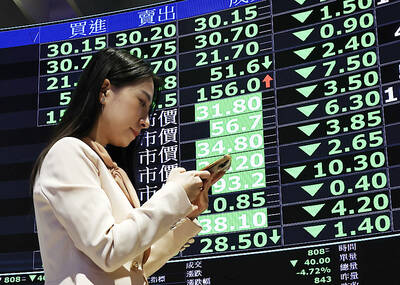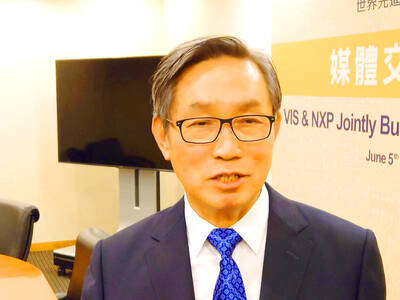E Ink Holdings Inc (元太科技), the world’s sole supplier of e-paper displays for e-readers and shelf labels, posted its best quarterly net profit for the first quarter in nine years amid increased demand during a traditionally slow season.
Net profit soared 80 percent to NT$787 million (US$26.23 million) in the quarter ended March 31, compared with NT$438 million a year earlier. That translated into earnings per share of NT$0.69, up from NT$0.39.
E Ink posted lower royalty income of NT$371.23 million last quarter from NT$448.74 million a year earlier, a company financial statement showed.
E Ink said that it expects royalty income to continue to fall this quarter due to increasing adoption of rivals’ OLED technology.
Gross margin jumped to 46.2 percent from 42.4 percent in the prior year, as it shipped more e-paper display films, which delivered a higher margin than fully assembled e-paper display modules with panels attached.
The Hsinchu-based company expects growth momentum to continue this quarter, with strong demand for electronic shelf labels and color e-paper displays mainly for e-readers.
“The second quarter looks like a stronger quarter than the same period last year. Outlook for the second quarter is relatively positive,” E Ink chairman Johnson Lee (李政昊) told an investors’ teleconference on Thursday.
E Ink’s revenue this quarter might surpass the NT$3.56 billion in the second quarter last year, which would mean revenue grew more than 22 percent from last quarter’s NT$2.92 billion, the company said.
The COVID-19 pandemic is accelerating adoption of electronic shelf labels, which allow retailers to update product price displays automatically from a central controller, it said.
However, some installations are to be delayed due to lockdowns in many countries to curb the spread of the virus, the company said.
Robust demand for color printing e-paper displays due to their affordability has far surpassed its expectations, E Ink said.
Due to limited capacity, order backlogs would not be digested until August or September, Lee said.
E Ink is racing to expand capacity for the color e-paper displays to satisfy demand, he said.
China’s iFLYTEK Corp (科大訊飛) plans to roll out new e-readers equipped with E Ink’s color displays this quarter, E Ink said.
European e-reader maker PocketBook also plans to launch color e-readers that adopt E Ink’s technology, it said.
Meanwhile, Hisense Electric Co (海信) is adopting E Ink color displays for its new smartphone.
The Chinese firm said it plans to allocate 15 percent more capital spending this year than last year.
Over the past few years, E Ink has spent NT$700 million to NT$800 million a year on new equipment and facilities.

TARIFFS: The global ‘panic atmosphere remains strong,’ and foreign investors have continued to sell their holdings since the start of the year, the Ministry of Finance said The government yesterday authorized the activation of its NT$500 billion (US$15.15 billion) National Stabilization Fund (NSF) to prop up the local stock market after two days of sharp falls in reaction to US President Donald Trump’s new import tariffs. The Ministry of Finance said in a statement after the market close that the steering committee of the fund had been given the go-ahead to intervene in the market to bolster Taiwanese shares in a time of crisis. The fund has been authorized to use its assets “to carry out market stabilization tasks as appropriate to maintain the stability of Taiwan’s

STEEP DECLINE: Yesterday’s drop was the third-steepest in its history, the steepest being Monday’s drop in the wake of the tariff announcement on Wednesday last week Taiwanese stocks continued their heavy sell-off yesterday, as concerns over US tariffs and unwinding of leveraged bets weighed on the market. The benchmark TAIEX plunged 1,068.19 points, or 5.79 percent, to 17,391.76, notching the biggest drop among Asian peers as it hit a 15-month low. The decline came even after the government on late Tuesday authorized the NT$500 billion (US$15.2 billion) National Stabilization Fund (國安基金) to step in to buoy the market amid investors’ worries over tariffs imposed by US President Donald Trump. Yesterday’s decline was the third-steepest in its history, trailing only the declines of 2,065.87 points on Monday and

TARIFF CONCERNS: The chipmaker cited global uncertainty from US tariffs and a weakening economic outlook, but said its Singapore expansion remains on track Vanguard International Semiconductor Corp (世界先進), a foundry service provider specializing in producing power management and display driver chips, yesterday withdrew its full-year revenue projection of moderate growth for this year, as escalating US tariff tensions raised uncertainty and concern about a potential economic recession. The Hsinchu-based chipmaker in February said revenues this year would grow mildly from last year based on improving supply chain inventory levels and market demand. At the time, it also anticipated gradual quarter revenue growth. However, the US’ sweeping tariff policy has upended the industry’s supply chains and weakened economic prospects for the world economy, it said. “Now

Six years ago, LVMH’s billionaire CEO Bernard Arnault and US President Donald Trump cut the blue ribbon on a factory in rural Texas that would make designer handbags for Louis Vuitton, one of the world’s best-known luxury brands. However, since the high-profile opening, the factory has faced a host of problems limiting production, 11 former Louis Vuitton employees said. The site has consistently ranked among the worst-performing for Louis Vuitton globally, “significantly” underperforming other facilities, said three former Louis Vuitton workers and a senior industry source, who cited internal rankings shared with staff. The plant’s problems — which have not